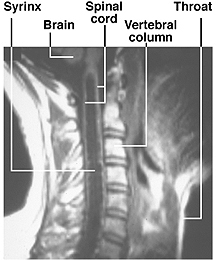by James W. Little, MD, PhD, Associate Professor in the Department of Rehabilitation Medicine at the University of Washington, and Assistant Chief of the Spinal Cord Injury Service at the VA Puget Sound Health Care System
Originally published in the Fall 1998 issue of Spinal Cord Injury Update.
Syringomyelia is an uncommon but disabling complication of SCI. Although more than half of all people with SCI develop a cyst in the spinal cord at the injury site, only about 4% develop syringomyelia, in which the cyst fills with fluid and expands. This enlarged cyst, or syrinx, can damage the spinal cord and cause pain, loss of sensation, or weakness. Other symptoms may include low blood pressure with light-headedness, sweating, increased or decreased spasms, and impaired bladder emptying. In some cases, syringomyelia results in major loss of function.
Syrinxes (the dark area in the center of the spinal cord, which is a lighter grey, shown at right) form when the normal flow of cerebrospinal fluid is obstructed by either a bony narrowing of the spinal canal or the presence of scar tissue at the injury site. Coughing, sneezing, bearing down, or lifting a heavy weight may contribute to syrinx development because these activities increase pressure in the veins, forcing fluid into the cyst. Spinal fluid is thought to flow through channels that act as one-way valves: fluid flows in but little flows out. Pressure builds in the syrinx until it enlarges and ruptures, damaging normal spinal cord tissue and injuring nerve cells.
Syrinxes are diagnosed by magnetic resonance imaging (MRI), but patients can often detect the presence of a syrinx by testing themselves for loss of pin-prick and temperature sensation, which are early signs of syringomyelia. Quantitative strength tests and nerve conduction tests are useful for monitoring syrinx status and assessing the effectiveness of treatments. Nerve conduction tests can also help detect other causes of neurologic decline that may mask or occur simultaneously with a syrinx, such as carpal tunnel syndrome, other peripheral nerve entrapment, or spinal cord impingement.
Surgery is often used to prevent syrinxes from expanding. A shunt tube can be placed in the syrinx to drain fluid into the abdominal cavity. In a dural graft procedure, the space around the spinal cord is enlarged to allow free flow of fluid and reduce pressure. A cordectomy involves cutting across the spinal cord and opening up the syrinx to release fluid. All of these surgical procedures have risks and limitations, and none is ideal in patients with incomplete injuries and preserved motor function below the syrinx because of the risk that the surgery may result in the loss of some or all of this function. Although shunts are standard treatment in patients with complete injuries, there is a risk that the shunt tube will occlude (close up) and the syrinx will reaccumulate fluid, resulting in further neurologic decline. In some patients who receive dural grafts, symptoms worsen despite the surgery. Patients should continue to be closely monitored after surgery for signs of further neurological decline.
Non-operative treatments for syringomyelia usually result in only modest and temporary improvements. Water pills and vasoconstrictor medications may help reduce fluid formation around the spinal cord. Avoiding activities that increase venous pressure – high force and breath-holding exercises, a head-down position, and bending the trunk so the chest rests on the thighs – may reduce the risk of syrinx expansion. Quad coughing, in which a care giver compresses the abdomen during an attempted cough to improve its effectiveness, may cause pressure in the inferior vena cava (a large vein in the abdomen) that can be transmitted to the syrinx. To avoid direct pressure on this vein, compressions can be performed to one side of the center of the abdomen. Draining the syrinx with a needle can also yield temporary benefits, but fluid tends to reaccumulate. Treatments currently available are most useful for preventing further neurologic decline but may also improve strength and decrease pain.
Syrinxes and their symptoms vary a great deal from patient to patient. Weakness and pain may or may not be present, and weakness can develop rapidly or gradually. Patients with syringomyelia often need a wide range of rehabilitation services to help them manage pain and adjust to new weakness or loss of function. Regular follow-up with a rehabilitation practitioner experienced in the long-term management of syrinxes is essential in order to monitor symptoms, guide treatments, and prevent neurologic decline.
Reprinted with permission from Spinal Cord Injury Update, the newsletter of the Northwest Regional Spinal Cord Injury System (University of Washington Department of Rehabilitation Medicine, Box 356490, Seattle, WA 98195-6490; 206/685-3999).


